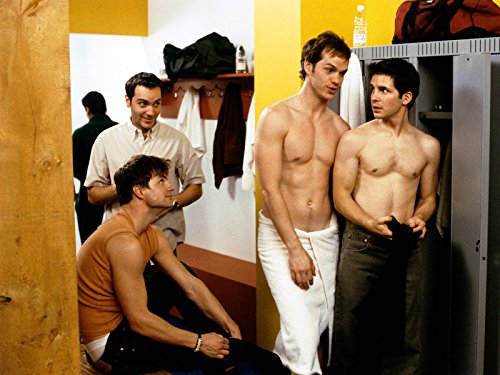Writing Rainbow: How ‘Queer as Folk’ transformed the gay experience on television

Showtime series “Queer as Folk” aired from 2000 to 2005. The series, starring Gale Harold, Scott Lowell, Peter Paige and Hal Sparks, follows a group of friends navigating adulthood. (Photo from IMDb)
I often imagine the possibility of a TV series documenting the daily lives of gay people. Wouldn’t it be fascinating to watch a drama about guys using Grindr, meeting strangers in WeHo nightclubs or simply navigating their queer identities in 2018? Don’t get me wrong — I absolutely adore Kurt and Blaine, Ian and Mickey, Cameron and Mitchell, among other same-sex couples on primetime TV. But what about a show solely focused on LGBTQ+ characters?
While shows like “RuPaul’s Drag Race” and “Queer Eye” have made strides in highlighting queer culture and identity on the small screen during their respective runs, there is not yet a modern series specifically dedicated to the personal narratives of queer life. HBO’s “Looking” came out in 2014, but it lacked the zest to make an impact on pop culture. But rewind to 2000, when Showtime premiered its groundbreaking drama “Queer as Folk.” With its historic five-year run, the show boldly revolutionized the portrayal of LGBTQ+ individuals in American media. Now that’s a game changer.
I was first exposed to the series when I was 6 years old, after accidentally stumbling upon my brother watching a raunchy sex scene between two men from the show. Scarred as I was, that may have been the moment I learned what being gay meant — and look where I am now. Sixteen years later, on the first day of Pride Month, I decided to revisit the show and binge its entirety on Netflix — a decision that has come to deeply alter my perception of the queer community.
Set in Pittsburgh, “Queer as Folk” follows the lives of five gay men and a lesbian couple. Complex, nuanced and deeply captivating, Ron Cowen and Daniel Lipman did not hold back when they recreated Russell T. Davies’ British series of the same name.
Protagonist Michael Novotny delivers this exact line to open the series: “The first thing you have to know is it’s all about sex.” And to a certain extent, he’s right. In the pilot, viewers are introduced to 17-year-old Justin Taylor, who loses his virginity to ad executive Brian Kinney — all within a span of 50 minutes. This was the first of many more explicit gay and lesbian sex scenes featured on the show. While HBO’s “Sex and the City” first aimed to normalize the previously taboo subject of sex when it came out in 1998, “Queer as Folk” pushed the boundaries even further by shedding light on same-sex relationships.
Provocative, daring and unapologetic, the Showtime series tackled a variety of real-life issues that were deemed too controversial and edgy for mainstream audiences at the time. It destigmatized HIV/AIDS with characters like Vic Grassi and Ben Bruckner. It provided newfound insight into drug abuse issues within the queer community. It highlighted the importance of fighting homophobia and for LGBTQ+ activism. It provided a snapshot of queer life in the early 2000s, as well as the problems facing the community. Most importantly, “Queer as Folk” did what no other show could at the time — it humanized an entire population that had been previously underrepresented and typecasted across all media.
That is not to say “Queer as Folk” did not have its faults. First, the show lacked diversity, as most of its main cast was white. While the characters’ racial identities did not necessarily detract from the storytelling, the reality is that the LGBTQ+ community is much more diverse, with different issues and perspectives facing each segment of the population. This flaw made me question whether or not I fit into the dominantly white narrative as a person of color. Moreover, the show fed into toxic stereotypes of hypermasculinity and sexual hierarchies among gay people at times, whether intentional or not.
Despite its shortcomings, “Queer as Folk” is still a seminal work in LGBTQ+ media. Over the course of half a decade, the series broke barriers when it came to displaying same-sex romance and sex, and had a full cast of dynamic characters when most other queer characters were stereotyped and staticized by mainstream showrunners. Even at its most provocative, “Queer as Folk” teaches its viewers what media representation can be — and the show was unafraid and brave enough to bare it all (literally) for its audiences.
After watching the show as a 21-year-old man, I was reminded that my story, as well as the stories of so many others, can still be told. In all its glory, “Queer as Folk” was a multi-faceted exploration — and deep dive — into LGBTQ+ identity and culture. To show gay sex was one thing, but to explore so many other real-life topics like infidelity, addiction, romance and careers? “Queer as Folk” was way ahead of its time and 13 years after its conclusion, its stories remain relevant and reflective of the issues queer individuals (young or old) experience.
If this show has taught me anything, it’s that 2018 needs to do some catching up of its own — and that I must further engage in issues affecting my community, continue the fight for diverse representation, and of course, be unapologetically queer.
Allen Pham is a senior majoring in public relations. He is also the editor-in-chief of the Daily Trojan. His column, “Writing Rainbow,” runs every other Friday.
